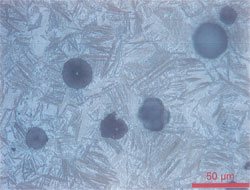What is Austempered Ductile Iron (ADI)?
Austempered ductile iron castings, or more commonly ADI castings, is a ductile iron casting which is processed by a special heat treatment. The austempering process, with ductile iron’s superior castability, results in a material which can be used to cast complex shapes, with a greater consistency of quality, and often at less cost. The heat treatment requires an interrupted quench, usually into a salt bath, to cool the cast part at a planned rate and long enough to achieve the desired austempered result. The resulting material has a combination of exceptional strength and toughness, meeting and often exceeding those of alloy steels.
What are some Benefits of Austempered Ductile Iron Castings?
- Up to 40% less cost than hardened steel forgings.
- Lower operating noise levels.
- 10% less weight than steel.
- Better wear than case hardened steel.
- Excellent resistance to crack propagation.
- Good impact strength to -120ºF.
- Work hardening.
What Can Austempered Ductile Iron Castings (ADI) be Used for? – Application Data
Austempered ductile iron (ADI) is often used where high strength is needed and where excellent wear resistance and fatigue strength are required. Applications like for gears ADI has been used with great success. This tough work-hardening material has proved to be an excellent replacement for hardened steels. The use of austempered ductile iron can result in less weight, reduced number of components, and quieter running. Due to the lower modulus of ADI better face to face contact can be achieved which reduces Hertzien or contact stress on the teeth surfaces. Also austempered ductile iron will work harden which adds to the contact fatigue strength. As a result, gear face widths and diameters can be reduced which will make the gear run better axially and reduces weight, and at the same time provide better protection under overload conditions. The superior tribological properties of ADI have resulted in the elimination of bronze bearing bushings, and will allow the gears to run temporarily without lubrication. Due to the type of matrix structure, the softer grades of ADI can be shot-peened to double the root fatigue strength.
Another common application of austempered ductile iron castings has been crankshafts and axles. The majority of sealed-for-life refrigeration units are made with austempered crankshafts. Axle applications benefit from the materials lack of notch sensitivity, good fatigue strength, and reasonable machinability.
The railroad industry has an immense application both in retarders and rolling stock. Austempered ductile iron is very popular for retarder brake shoes, where its superior quietness and wear resistance is well received in urban semi residential communities. ADI brake beams have also been shown to outlast steel beams, and withstand the cold weather, at more than 20% less cost.
For low speed rolling stock austempered ductile iron wheels have been very successful in Europe. It has been shown that ADI railroad wheels can take larger loads than quenched and tempered steel wheels of the same hardness. ADI will also wear better when sliding between the rail and wheel exceeds more than 10%. One caveat to ADI is that it should not be used in applications where the temperature exceeds 300ºC. (570ºF) for consistently long periods. Thus high speed train wheels are not an appropriate application, nor are wheels which are braked by peripheral blocks. will allow the gears to run temporarily without lubrication. Due to the type of matrix structure, the softer grades of ADI can be shot-peened to double the root fatigue strength.
The military is becoming a major user of austempered ductile iron for shells and projectiles. Also steel forged track shoes are being replaced with ADI It is estimated that over 50,000 tons are presently produced for these military applications, and that this will grow to over 100,000 tons within the next five years. Track shoes in ADI have also been very successful both in construction, and earth moving equipment.

The etched microstructure of Austempered Ductile Iron at higher magnification shows details of Ferritic needles in austenitic matrix.
What are typical ADI Applications?
- Abrasive Protection Liners
- Bearing Sleeves
- Brake Shoes
- Bushing Sleeves
- Cable Drums
- Camshafts
- Chain Sprockets
- Connecting Rods
- Crankshafts
- Cultivating Tools
- Differential Spiders
- Drive Shafts
- Engine Mounting Brackets
- Friction Blocks
- Ground Engaging Tools
- Guide Rollers
- Hydraulic Pump Bodies
- Piston Sleeves
- Pulleys
- Pump Impellers
- Rack and Pinion Gearing
- Rocker Arms
- Railroad Car Wheels
- Rollers and Sprockets
- Shredder Knives
- Steering Knuckles
- Trolley Wheels
- Wear Plates and Guides
- Wire Guides
Is Machining of Austempered Ductile Iron Difficult?
Machining of A.D.I. is generally speaking, possible, using normal machining techniques. Only the tapping of small diameter holes (especially dead end) and scraping of the softest type is very difficult due to work hardening. It is however common practice to machine to near final size and then heat treat. This is possible because the heat treatment is considered “soft”, and the consequent volume changes are small, and predictable with volume expansion of between only 0.2% – 0.4%.
You can also find out additional information on our Austempered Ductile Iron Application Data Fact Sheet.
For further information about the use and selection of austempered ductile iron talk to your Willman representative or contact our engineering staff at:
Willman Industries, Inc.
338 South Main St
Cedar Grove, WI 53013
Tel: (920) 668-8526
Fax: (920) 668-8998
E-Mail: hhunter@willmanind.com
Web: www.willmanind.com

